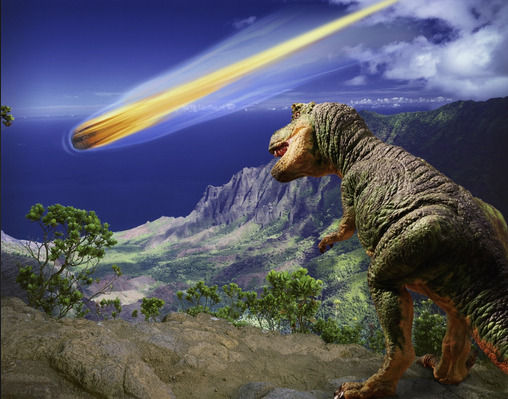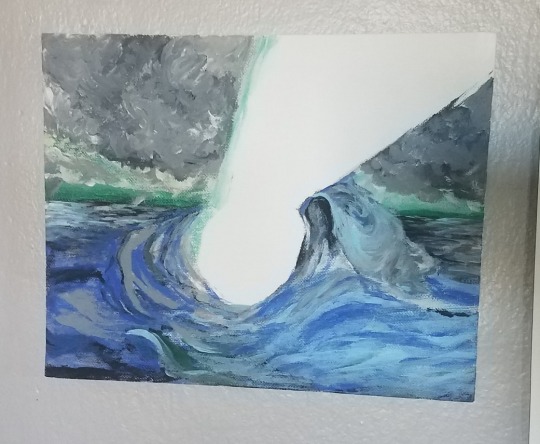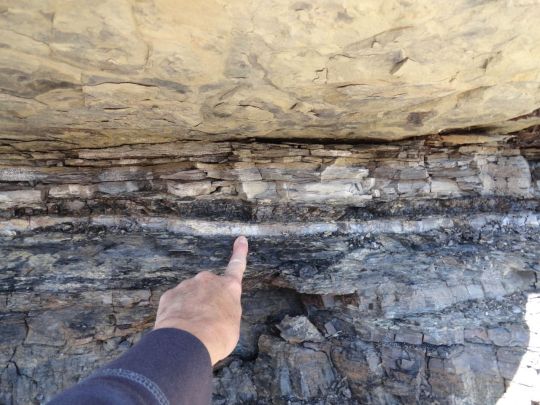#chicxulub impact
Text
unrelated but does anyone else think google's little bit when you search "Chicxulub Crater" is just a wee bit macabre
291 notes
·
View notes
Text




If you're in the US and a something of a science geek, I can highly recommend the recent Nova episodes that aired last week on PBS that covered the dig in North Dakota that provided the first fossil remains of animals that died on the day of the Chicxulub impact 66 million years ago. I knew about the heat pulse that killed the dinosaurs around the globe. But I didn't know anything about the massive tremors sent through the Earth that caused localized tidal waves thousands of miles away from the impact site.
2K notes
·
View notes
Text
Dinofact #20
The most supported theory of the cause of the Cretaceous-Paleogene Extinction Event is the bolide impact hypothesis, which states that most the dinosaurs (excepting aves, modern-day birds) were extincted by a meteor impact. This theory, proposed by Walter Alvarez, Luis Alvarez, and colleagues in 1980, is supported by increased iridium deposits worldwide and the Cretaceous-Paleogene boundary, as well as shocked quartz, also found worldwide. In 1991, a massive crater measuring 180 km (110 mi) wide was discovered in the Yucatán Peninsula of southeastern Mexico. Evidence suggests that an extraterrestrial projectile approximately 5 to 15 kilometers (3 to 9+1⁄2 miles) wide impacted the site 66 million years ago, causing a chain of tsunamis, earthquakes, wildfires, and other disasters, that led to an "impact winter", leading to the extinction of all dinosaurs except for grain-eating birds.
Sources: wikipedia, the Smithsonian Magazine
#dinosaur#dinosaurs#paleontology#birds#extinction#dinosaur extinction#extinction event#cretaceous–paleogene extinction event#walter alvarez#luis alvarez#chicxulub#chicxulub crater#chicxulub impact#yucatan#yucatán#yucatan peninsula#yucatán peninsula#mexico#southeast mexico#trivia#fun facts#dinosaur fun facts#dinosaur trivia#13th#september#2022#september 13th#september 2022#september 13th 2022
7 notes
·
View notes
Photo

2 notes
·
View notes
Text

Chicxulub impact
0 notes
Text
dragons were real
and their lungs
were full of smoke
0 notes
Photo

The Chicxulub crater is a massive impact crater located on the Yucatan Peninsula in Mexico. It is believed to have been formed around 66 million years ago when an asteroid or comet approximately 10 kilometers in diameter struck the Earth. This impact is thought to have caused the extinction of the dinosaurs and many other species, and it also had a profound impact on the evolution of life on Earth.
906 notes
·
View notes
Link
🌏 Get Our Exclusive NordVPN deal here ➼ https://www.nordvpn.com/spacenuts or use the checkout code SPACENUTS. It’s risk-free with Nord’s 30-day money-back guarantee! ✌
In this episode,hosts Andrew Dunkley and Professor Fred Watson delve into the cataclysmic demise of the dinosaurs, exploring various extinction theories with a fervent quest for truth, unraveling the enigmatic ancient puzzle while seeking to unearth the ultimate cause. In this episode, you will be able to:
·
Explore the fascinating theories behind the extinction of dinosaurs and gain a deeper understanding of this monumental event in Earth's history.
·
Discover the impact that star growth has on planets orbiting around them, unraveling the intriguing dynamics of celestial bodies.
·
Delve into the mysteries of the Andromeda galaxy, known for its massive black holes, and uncover the secrets hidden within its immense expanse.
·
Learn how gravity and Hawking radiation intertwine, shedding light on the intricate relationship between these fundamental forces of the universe.
·
Immerse yourself in the captivating discussions from the Space Nuts podcast, where space enthusiasts and science lovers engage in thought-provoking conversations about our vast cosmos.
·
Gain a deeper understanding of the theories surrounding the extinction of dinosaurs and uncover the mysteries behind their disappearance.
·
Explore the fascinating impact of star growth on orbiting planets, and how it influences the conditions necessary for life to exist.
·
Discover the captivating secrets of the Andromeda galaxy and its enigmatic black holes, expanding your knowledge of the vastness of the universe.
·
Unravel the intricate interplay between gravity and Hawking radiation, and its implications for our understanding of the fundamental laws of physics.
·
Delve into the Space Nuts podcast discussions and indulge your curiosity in a wide array of captivating space-related topics, offering a unique opportunity to expand your knowledge and engage with fellow space enthusiasts. It's extraordinary that 40 years after it was suggested, we're still finding out about this impact and seeing different aspects to it because of the devastation that it caused. - Andrew Dunkley
The extinction of dinosaurs has been a topic of intrigue for centuries. Various theories propose the cause to be major environmental changes, catastrophic asteroid impact, or major shifts in vegetation, leading to dental maladies among the dinosaurs. The most recent development in this field proposes a global winter induced by the fallout of an asteroid impact, a theory which aligns with the devastation level required to cause such a mass extinction. The resources mentioned in this episode are:
·
Visit thecosmosmagazine.com website to read more about the new theory on what caused the extinction of the dinosaurs.
·
Check out the paper titled Chicxulub Impact Winter, sustained by fine silicate dust in the journal Nature Geoscience for more details on the research.
·
Explore the concept of the Anthropocene period and human-induced climate change by searching for articles and studies on the topic.
·
Learn more about the sun and its evolution by researching yellow dwarf stars and stellar evolution.
·
Discover more about the star Ro Corona Borealis and its similarities and differences to our own sun by searching for information on the star and its characteristics.
·
Read the paper by Stephen Kane in the Astrophysical Journal to delve deeper into the research on planets orbiting sunlike stars.
·
In this episode of the Space Nuts podcast, you'll join host Andrew Dunkley as he delves into the fascinating world of space exploration and scientific discoveries. With his friendly and approachable style, Andrew takes you on a journey through various topics, from the theories surrounding the extinction of dinosaurs to the lifecycle of stars and the interplay between galaxies and black holes. He effortlessly combines scientific knowledge with humor and curiosity, making complex concepts accessible to all. Whether you're a space enthusiast or simply curious about the mysteries of the universe, this episode of Space Nuts is sure to captivate your imagination and leave you with a deeper understanding of our cosmic surroundings. So sit back, relax, and get ready to embark on an interstellar adventure with Andrew Dunkley and his guests on Space Nuts. Timestamped summary of this episode:
00:00:00 - Introduction
Andrew Dunkley introduces the episode and previews the topics to be discussed, including the extinction of the dinosaurs, planets orbiting a star similar to ours, and audience questions about Andromeda gravity.
00:05:38 - New Theory on Dinosaur Extinction
Astronomers in Belgium and the UK have proposed a new theory on the extinction of the dinosaurs. They have found evidence of fine silicate dust in the rock strata, suggesting that the impact of a massive asteroid led to a global winter, which caused the mass extinction event.
00:08:41 - Impact of Silicate Dust
The distribution of silicate dust from the asteroid impact was larger than previously estimated. This fine dust, about 1 micron in diameter, could have stayed in the atmosphere for an extended period, contributing to the global winter and the extinction of the dinosaurs.
00:02:16 - Fred's Travels
Fred Watson discusses his upcoming travels to Sea Lake in Victoria for an astronomy weekend and his trip to New Zealand for the hundredth anniversary of an astronomical society. He also mentions his participation in a meeting about dark and quiet skies and the impact of satellites on astronomers.
00:04:44 - Interesting Statistics
Andrew Dunkley shares interesting statistics, including the percentage of New Zealanders living in Australia (10% of their population) and the fastest-growing nationality moving to Australia (the Nepalese). He humorously advises Fred not to mix up Switzerland with Sweden, referencing a recent
00:17:05 - "Introduction to the Star's Lifecycle"
The star in question is a yellow dwarf in its midlife phase, approximately 4.57 billion years old. It is currently in a steady hydrogen burning phase, similar to the Sun. This phase will continue for another 4 billion years before it transitions into a giant star.
00:19:32 - "Planets Orbiting the Star"
The star, Ro Corona Borealis, has four known planets orbiting it. These planets are closer to the star than Mercury is to the Sun. One of the planets, Ro Corona Borealis d, is potentially in the habitable zone and could support life.
00:21:35 - "Impact of Star Growth on Planets"
As the star grows into a red giant, the planets' fate is uncertain. Some may evaporate or be torn apart by the gravitational effects. Others may be thrown out of the system and become rogue planets. The exact outcomes depend on the planets' orbits and interactions with other planets.
00:25:04 - "Predictions for the Planets"
The prediction for the four known planets is that one will evaporate within the star's atmosphere, one will spiral in and be tidally disrupted, one will be destroyed at the end of a phase of evolution, and the fate of the fourth planet is uncertain. There could also be other undetected planets that may survive or be influenced by the star's growth.
00:35:32 - The Spectacular Event of the Andromeda Galaxy
The speaker discusses the possibility of the Andromeda galaxy getting closer to our galaxy. Although the event would be spectacular, it would happen on a timescale that wouldn't affect us humans.
00:36:27 - Collision of Galaxies
The collision between our galaxy and the Andromeda galaxy would result in a phenomenal sight, but it would be a slow process that wouldn't impact us directly. Simulations indicate that the two galaxies will pass through each other multiple times before settling into a new galaxy devoid of hydrogen.
00:37:33 - Black Hole Merger
In response to a listener's question, it is mentioned that the black holes in the Milky Way and Andromeda galaxies would eventually merge due to their relative gravitational forces. This merging process is expected to happen during the collision of the two galaxies.
00:38:59 - Can Gravity Escape a Black Hole?
The question of whether gravity can escape a black hole is explored. Gravity is a force field associated with a theoretical particle called a graviton, but it has never been observed or confirmed. The escape of gravitons from a black hole remains uncertain.
00:41:23 - The Myth of Bagpipes on the Moon
The story of a mechanic named William Rudd playing bagpipes at the Tidbin Biller station during the Apollo program is shared. While it is unclear if the sound of the bagpipes was actually heard on the moon,
The extinction of dinosaurs has been a topic of intrigue for centuries. Various theories propose the cause to be major environmental changes, catastrophic asteroid impact, or major shifts in vegetation, leading to dental maladies am
#asteroid#changes#chicxulub#cretaceous-paleogene#dental#dinosaur#dinosaurs#dust#environmental#extinction#fine#impact#of#plaque#problems#silicate#theories#tsunamis#winter
8 notes
·
View notes
Text
Just heard about the KPg mass extinction. SAD. Oh well, there's other animals.
#shitpost#comedy#humor#sad#kpg mass extinction#dinosaurs#paleontology#paleoblr#mesozoic#chicxulub impact event
62 notes
·
View notes
Text
strongly believe everyone should go through their tumblr likes once in a while. keeps you humble. it's like looking through the strata on an archeological site.
#2016 was the chicxulub impact#between the new star wars and the election it significantly impacted my likes#also i wrote a novel that year so there was lots of writing tip stuff#none of which I saved or ever referenced apparently
0 notes
Link
“Why did the dinosaurs become extinct?”
“Because they didn’t have a space program!”
1 note
·
View note
Text
"goodbye volcano high doesn't have alternate endings what the fuck I hate it!"
you are aware of end-cretaceous extinction I'm assuming? and how it was... in fact... unavoidable?
anyways welcome to the club of people who mourn the Chicxulub impact, here's your official snapback and mourner's flag. we have club meetings every Tuesday where we talk about what would have happened if the asteroid hadn't hit and cry over nonavian dinosaurs, pterosaurs, and nonturtle marine reptiles
and always, major shout out to Jupiter for preventing more world-ending impacts from happening. Huge round of applause for that big beautiful planet!
339 notes
·
View notes
Text
thought 1: dwarf fortress but on an asteroid sounds rad as hell
thought 2: “strike the earth!” would have a very, very different meaning in that context
0 notes
Note
What happened the to asteroid itself after the huge Impact? Was it just eroded away? With how big it was, there’s gotta be at least pieces of it left, right? This is thing that always get me with stuff like this. People almost never talk about what happened to the asteroid, though I don’t really have enough interest to seek the info myself so that could just be me not looking
most of the Chicxulub asteroid was vaporized on impact and settled into a layer of fine particles that's found in rock layers worldwide, but it also actually did punch all the way through the crust and into the mantle, completely destabilizing Earth's volcanic cycle, so slight traces of it may still exist inside the Earth as well!
but yeah this is what it looks like now:

that's the asteroid that killed the dinosaurs. it's both everywhere and nowhere.
36K notes
·
View notes
Text
Success! Defence Against Asteroids
Success! Defence Against Asteroids
Most people will know that about 64 million years ago an asteroid with a diameter of about 10 km struck the Yucatán peninsula and exterminated the dinosaurs, or at least did great damage to them from which they never recovered. The shock-wave probably also initiated the formation of the Deccan Traps, and the unpleasant emission of poisonous gases which would finish off any remaining dinosaurs.…
View On WordPress
#asteroid impact consequences#Chicxulub#DART#Didymos#Dimorphos#gravitational tethering#LICIACube#orbital dynamics
0 notes